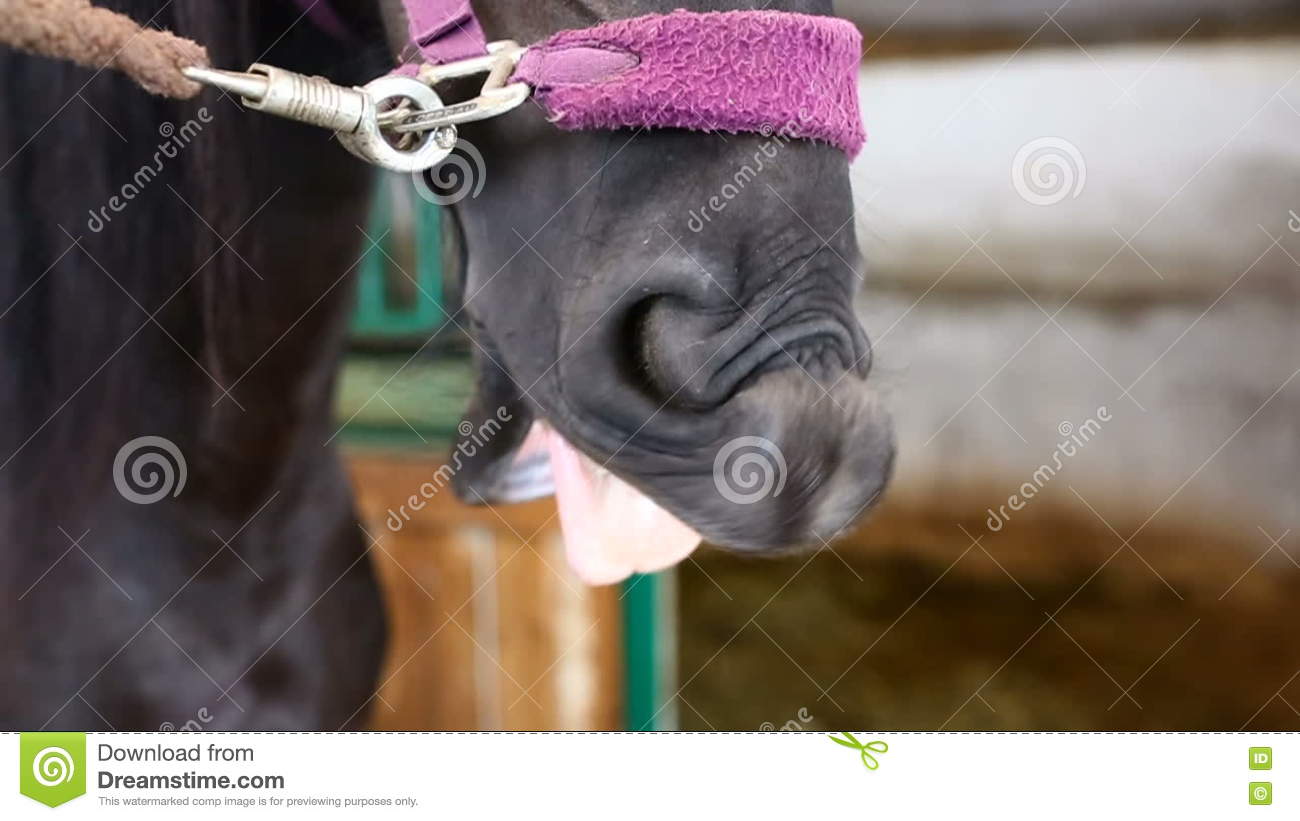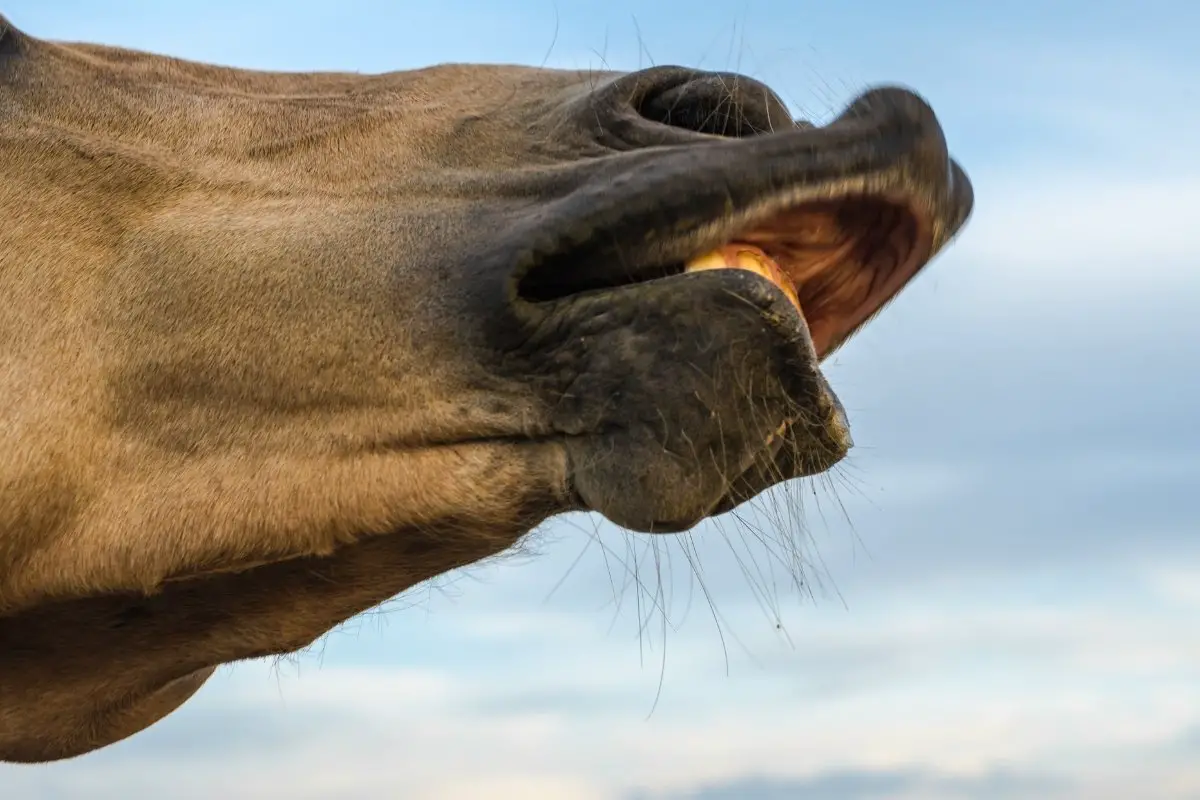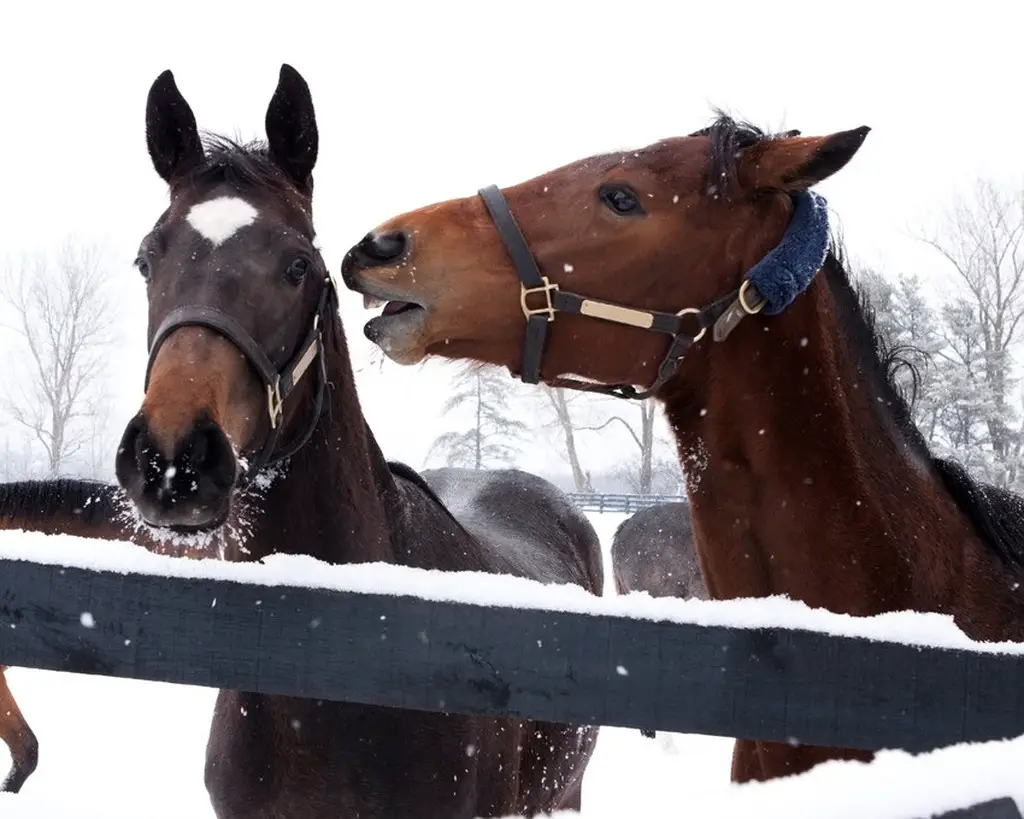Horses are an iconic part of human culture, and their behavior is often fascinating to observe. One such behavior is lip flapping, the act of a horse quickly opening and closing its lips. In this article, we will explore the reasons why horses flap their lips and the implications it has for their well-being.
Anatomy of the Horse’s Mouth

Understanding the anatomy of the horse’s mouth is essential in order to understand why horses flap their lips. The horse’s mouth is composed of several parts:
- Tongue – This is a muscular organ located on the floor of the mouth and is used for tasting and manipulating food. The tongue is also used to move food around in the horse’s mouth while it is being chewed.
- Teeth – The horse has two sets of teeth: incisors, which are used for cutting food, and molars, which are used for grinding and chewing. The horse’s incisors are large and flat, and the molars are wide and flat.
- Gums – The gums are the soft tissues that line the outer edges of the teeth. The gums are sensitive and can be easily injured by sharp objects. The gums are also important for keeping the teeth in place.
- Lips – The lips are the fleshy parts of the mouth, and they are used to move food around in the mouth. The lips are also used to grasp objects, such as a bit or a carrot. The lips are sensitive, and they are easily injured by rough objects.
- Cheeks – The cheeks are the fleshy parts of the face that are used to move food around the mouth. The cheeks are also used to express emotions, such as when a horse is happy or scared. The lips and cheeks work together to help the horse move food around in the mouth.
Knowing the anatomy of the horse’s mouth can help us understand why horses flap their lips. By understanding the structure and purpose of the various parts of the mouth, we can better understand how horses use their lips and how they communicate with us.
The Purpose of Lip Flapping in Horses

Horses are known to flap their lips for a variety of reasons. This behavior can be seen in both domestic and wild horses and is a normal part of horse communication. The following are some of the most common reasons why horses flap their lips.
Grasping Objects
Horses have sensitive lips and use them to grab and hold onto objects. This is most often seen when horses are eating hay or grain, but can also be seen when horses are trying to pick up things like carrots or apples. Lip flapping is the horses’ way of getting a better grasp on the object they are holding.
Communicating with Other Horses
Horses use their lips to communicate with other horses. This behavior is often seen in horses when they are in close proximity to one another and are trying to establish dominance. Lip flapping can also be used as a sign of submission or to indicate that the horse is feeling threatened. Horses may also lip flap when they are trying to comfort or groom another horse.
Other Behaviors Associated with Lip Flapping

Lip flapping is not the only behavior horses exhibit when they are feeling stress or discomfort. Other behaviors associated with lip flapping include:
- Head tossing
- Stomping
- Nipping or biting
- Shaking their head
- Bolting
- Grinding their teeth
- Swinging their tail
- Swishing their tail
- Pinning their ears back
- Lifting their head up or down
- Rearing up
These behaviors can sometimes be difficult to identify in horses, and can be mistaken for other behaviors. It is important to observe the horse carefully in order to determine if they are exhibiting any of these behaviors in combination with lip flapping. This can help you better understand what is causing the horse to be stressed or uncomfortable.
What Horses Need to Flap Their Lips

Horses flap their lips for a variety of reasons, such as to express excitement, to show submissiveness, and to communicate with other horses. To perform this behavior, horses need a few key components: a strong upper lip, a relaxed lower lip, and a relaxed jaw.
A strong upper lip is necessary for horses to be able to flap their lips in the first place. This is because the upper lip is responsible for creating the flapping motion. The upper lip is usually thicker and more muscular than the lower lip and is therefore able to create more movement.
The lower lip needs to be relaxed for the horse to be able to perform the lip flapping behavior. The lower lip is usually thinner, so it takes less effort to move it. If the lower lip is tense, the flapping motion will be inhibited.
Finally, horses need a relaxed jaw in order to flap their lips. A tense jaw can put pressure on the upper and lower lips, preventing them from moving freely. Therefore, it is important for horses to have a relaxed jaw in order for them to be able to perform this behavior.
Horses use lip flapping for a variety of reasons, such as to express excitement or to communicate with other horses. To be able to perform this behavior, horses need a strong upper lip, a relaxed lower lip, and a relaxed jaw. When all of these components are in place, horses are able to successfully communicate using their lips.
Adverse Effects of Lip Flapping

Lip flapping is a common behavior in horses, especially young horses, and it is thought to be a normal part of their development and self-expression. While this behavior can be quite endearing, there are some adverse effects to consider:
- It can cause over-salivation, which can lead to dehydration and a decrease in appetite.
- It can cause chapping and cracking of the lips, which can lead to infection.
- It can cause irritation of the mouth and lips, which can be painful and uncomfortable for the horse.
- It can be a sign of anxiety or stress, and can lead to further behavioral issues.
- It can lead to abrasions and sores in the mouth, which can be painful and cause further health issues.
It is important to monitor your horse’s lip flapping behavior and to intervene if necessary. If you notice that your horse is lip flapping excessively, it may be a sign of underlying health issues or emotional distress. It is best to consult your veterinarian to determine the cause and to provide the appropriate treatment.
Types of Horses That are Prone to Lip Flapping

Horses may flap their lips due to a variety of reasons. While some horses may lip flap due to anxiety or fear, others may be exhibiting a natural behavior. In any case, the following breeds of horses are more prone to lip flapping than others.
- Arabians: Arabians are known for their high energy and tendency to be easily spooked. As a result, they may lip flap more than other breeds.
- Thoroughbreds: Thoroughbreds are highly sensitive and may lip flap when they feel anxious or uncomfortable.
- Quarter Horses: Quarter Horses are known for their strong personalities and can be prone to lip flapping when they feel threatened.
- Paint Horses: Paint Horses, which are a cross between Quarter Horses and Thoroughbreds, may lip flap if they feel threatened or anxious.
- Draft Horses: Draft Horses, such as Clydesdales and Shires, may lip flap due to their larger size and temperament.
No matter the breed, it is important to be aware of your horse’s behavior, as lip flapping can be a sign of distress. If your horse is lip flapping, it is best to investigate the cause and take the necessary steps to ensure the safety of your horse and those around them.
Tips to Prevent Lip Flapping
Lip flapping is a common behavior in horses, but it can be annoying and distracting for riders. Luckily, there are several steps you can take to prevent this behavior.
First, it’s important to properly fit your horse’s bridle and make sure it is not too tight or too loose. If the bridle is too tight, it can cause discomfort and lead to lip flapping. Additionally, if the bit is too loose, it can also cause discomfort and encourage lip flapping. So, be sure to check your horse’s bridle regularly.
Second, you can also try changing the type of bit your horse wears. If your horse is a heavy biter, try switching to a milder bit. In some cases, simply changing the type of bit can reduce or eliminate lip flapping.
Third, you can try introducing a bitless bridle. Bitless bridles can be a great alternative to traditional bits, as they provide a gentle, yet effective, way to control your horse. Bitless bridles can also help reduce or eliminate lip flapping.
Finally, be sure to provide plenty of mental and physical stimulation for your horse. Horses that are bored or stressed can develop bad habits, such as lip flapping. So, be sure to give your horse plenty of exercise and activities to help keep them from getting bored.
By following these tips, you can help prevent lip flapping in your horse. With a little patience and effort, you can help reduce or eliminate this behavior and have a better riding experience.
Frequently Asked Questions
1. What is the purpose of a horse flapping its lips?
- The primary purpose of a horse flapping its lips is to communicate. Horses are very social animals and will use their lips to express a wide range of emotions and behaviors.
- Lip flapping can be used to express fear, excitement, curiosity, and even aggression. It is also used to communicate with other horses and to show submission to a dominant horse.
- Horses may also flap their lips when they are exploring an unfamiliar object or area, or when they are searching for food.
- In addition to communication, horses may flap their lips as a way to cool down or to protect themselves from flies or other insects.
- Finally, horses may flap their lips to show pleasure or contentment. Flapping their lips is a sign of relaxation and comfort and can also indicate that a horse is ready to receive a treat.
2. How often do horses wiggle their lips?
Horses typically wiggle their lips in order to communicate with one another. They often do this when they are trying to get another horse’s attention or when they are asking for something. It is also a sign of contentment or happiness, as horses will often wiggle their lips when they are happy or relaxed.
Horses usually wiggle their lips quite often, though the frequency of the wiggling depends on the individual horse and the situation. Some horses may wiggle their lips multiple times in a day, while others may only do it a few times a week.
- Horses wiggle their lips to communicate with one another
- It is a sign of contentment or happiness
- The frequency of the wiggling depends on the individual horse and the situation
- Some horses may wiggle their lips multiple times in a day, while others may only do it a few times a week
3. How can I tell when a horse is flapping its lips?
When a horse is flapping its lips, you’ll be able to observe the following signs:
- The horse will be making a smacking or chewing motion with its lips.
- The horse may also be producing a clicking sound with its tongue.
- The horse’s lips will be moving up and down quickly.
- The horse may also be curling its upper lip up and down.
It is important to note that the horse may be flapping its lips for a variety of reasons, so it is best to observe the horse’s body language to determine the motivation behind the behavior.
4. What is the Scientific Name for the Action of a Horse Flapping its Lips?
The scientific name for the action of a horse flapping its lips is called flehmen. This is a behavior seen in horses, as well as several other species, that is used to collect more information about their environment. Specifically, it is used to detect pheromones in the air.
- Flehmen is a behavior seen in horses, as well as other species.
- It is used to collect more information about their environment.
- Specifically, it is used to detect pheromones in the air.
5. Are there any benefits to a horse wiggling its lips?
Horses wiggling their lips, also known as lip curling, is a behavior that has puzzled horse owners for centuries. While it may not be immediately obvious, there are actually some benefits to this behavior.
- Relieving Stress: Wiggling their lips is one way that horses can express their stress or anxiety. This behavior can help them to feel more relaxed, and can even help to reduce pain.
- Self-Grooming: By curling their lips, horses can reduce the amount of dirt and debris that accumulates in their whiskers. This helps them to groom themselves more effectively, and keep their coats looking neat and clean.
- Communication: Horses often use lip curling as a way to communicate with other horses. It can be used to indicate a variety of things, such as curiosity, friendliness, or aggression.
- Improved Sense of Smell: A horse’s sense of smell is much more sensitive than ours, and wiggling their lips can help them to pick up even more subtle scents. This can help them to better identify potential threats or food sources.
- Protection: When a horse is feeling threatened, they may curl their lips to expose their teeth. This is an intimidating display that can be used to ward off potential predators or other animals.
Overall, lip curling is an important behavior that horses use to express themselves, communicate with others, and protect themselves from potential threats. This behavior can help horses to stay safe, healthy, and in touch with their environment.
Conclusion
Horses flap their lips for a variety of reasons, and this behavior is an important part of their communication with humans and other horses. Horses may use lip flapping to express their emotions, to show dominance, and to show submission. They may also use lip flapping when they are excited, when they are stressed, or when they are trying to get rid of irritating insects. By understanding why horses flap their lips, we can better understand their behavior and be better able to communicate with them.
References
- Why Do Horses Flap Their Lips?, PetMD, Accessed April 05, 2019
- What does it mean when a horse flaps its lips?, Horse Talk, Accessed April 05, 2019
- Why horses flap their lips, Purdue University, Accessed April 05, 2019



